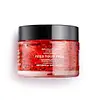What's inside
What's inside
 Key Ingredients
Key Ingredients

 Benefits
Benefits

 Concerns
Concerns

 Ingredients Side-by-side
Ingredients Side-by-side

Glycerin
HumectantActinidia Chinensis Seed
AbrasiveParfum
MaskingPhenoxyethanol
PreservativePEG-40 Hydrogenated Castor Oil
EmulsifyingTrideceth-9
EmulsifyingWater
Skin ConditioningCarbomer
Emulsion StabilisingBenzophenone-4
UV AbsorberSodium Hydroxide
BufferingPropylene Glycol
HumectantCitrullus Lanatus Fruit Extract
Skin ConditioningPotassium Sorbate
PreservativeSodium Benzoate
MaskingDenatonium Benzoate
MaskingCI 14700
Cosmetic ColorantCI 17200
Cosmetic ColorantWater
Skin ConditioningButylene Glycol
HumectantPropanediol
SolventPEG-40 Hydrogenated Castor Oil
EmulsifyingTrideceth-9
EmulsifyingTriethanolamine
BufferingCarbomer
Emulsion StabilisingRosa Centifolia Leaf Cell Extract
AntioxidantRosa Alba Leaf Cell Extract
AntioxidantRosa Damascena Leaf Cell Extract
Skin ProtectingRosa Canina Fruit Extract
AstringentRosa Damascena Flower Oil
MaskingRosa Canina Fruit Oil
EmollientRosa Centifolia Flower Water
Skin ConditioningCommiphora Myrrha Leaf Cell Extract
MaskingAdenium Obesum Leaf Cell Extract
MaskingLeuconostoc/Radish Root Ferment Filtrate
AntimicrobialGlycerin
HumectantAllantoin
Skin ConditioningAloe Barbadensis Leaf Juice
Skin ConditioningBHT
AntioxidantSodium PCA
HumectantPropylene Glycol
HumectantEthylhexylglycerin
Skin ConditioningPPG-26-Buteth-26
Skin ConditioningEthylhexyl Salicylate
UV AbsorberButyl Methoxydibenzoylmethane
UV AbsorberEthylhexyl Methoxycinnamate
UV AbsorberDisodium EDTA
Potassium Sorbate
PreservativeCI 17200
Cosmetic ColorantWater, Butylene Glycol, Propanediol, PEG-40 Hydrogenated Castor Oil, Trideceth-9, Triethanolamine, Carbomer, Rosa Centifolia Leaf Cell Extract, Rosa Alba Leaf Cell Extract, Rosa Damascena Leaf Cell Extract, Rosa Canina Fruit Extract, Rosa Damascena Flower Oil, Rosa Canina Fruit Oil, Rosa Centifolia Flower Water, Commiphora Myrrha Leaf Cell Extract, Adenium Obesum Leaf Cell Extract, Leuconostoc/Radish Root Ferment Filtrate, Glycerin, Allantoin, Aloe Barbadensis Leaf Juice, BHT, Sodium PCA, Propylene Glycol, Ethylhexylglycerin, PPG-26-Buteth-26, Ethylhexyl Salicylate, Butyl Methoxydibenzoylmethane, Ethylhexyl Methoxycinnamate, Disodium EDTA, Potassium Sorbate, CI 17200
 Reviews
Reviews

Ingredients Explained
These ingredients are found in both products.
Ingredients higher up in an ingredient list are typically present in a larger amount.
Carbomer is a polymer of acrylic acid. Its main role is to create a gel consistency.
A high amount of carbomer can cause pilling or balling up of products. Don't worry, most products contain 1% or less of carbomer.
Ci 17200 is a synthetic reddish-purple dye.
Glycerin is already naturally found in your skin. It helps moisturize and protect your skin.
A study from 2016 found glycerin to be more effective as a humectant than AHAs and hyaluronic acid.
As a humectant, it helps the skin stay hydrated by pulling moisture to your skin. The low molecular weight of glycerin allows it to pull moisture into the deeper layers of your skin.
Hydrated skin improves your skin barrier; Your skin barrier helps protect against irritants and bacteria.
Glycerin has also been found to have antimicrobial and antiviral properties. Due to these properties, glycerin is often used in wound and burn treatments.
In cosmetics, glycerin is usually derived from plants such as soybean or palm. However, it can also be sourced from animals, such as tallow or animal fat.
This ingredient is organic, colorless, odorless, and non-toxic.
Glycerin is the name for this ingredient in American English. British English uses Glycerol/Glycerine.
Learn more about GlycerinPeg-40 Hydrogenated Castor Oil is derived from castor oil and polyethylene glycol (PEG). It is used as a emollient and emulsifier.
As an emulsifier, it helps prevent ingredients from separating. It also helps make the other ingredients more soluble; it is often used to solubilize fragrances. This increases spreadability and elongates shelf life in a product.
Emollients help soothe and soften the skin. They do this by creating a protective film on your skin. This barrier helps trap moisture and keeps your skin hydrated. Emollients may be effective at treating dry or itchy skin.
This ingredient may or may not be vegan, depending on the source.
Peg-40 Hydrogenated Castor Oil may not be fungal-acne safe. We recommend speaking with a professional if you have any questions or concerns.
Learn more about PEG-40 Hydrogenated Castor OilPotassium Sorbate is a preservative used to prevent yeast and mold in products. It is commonly found in both cosmetic and food products.
This ingredient comes from potassium salt derived from sorbic acid. Sorbic acid is a natural antibiotic and effective against fungus.
Both potassium sorbate and sorbic acid can be found in baked goods, cheeses, dried meats, dried fruit, ice cream, pickles, wine, yogurt, and more.
You'll often find this ingredient used with other preservatives.
Learn more about Potassium SorbatePropylene Glycol is an odorless, colorless liquid. As a humectant, it helps skin retain moisture. It also aids in delivering active ingredients.
Another role of this ingredient is preventing a product from melting or freezing. Propylene glycol also adds antimicrobrial properties to a product, elongating product lifespan.
This ingredient is considered an organic alcohol and commonly added into both cosmetics and foods.
Those with sensitive skin or conditions may develop a rash when using this ingredient.
Learn more about Propylene GlycolWe don't have a description for Trideceth-9 yet.
Water. It's the most common cosmetic ingredient of all. You'll usually see it at the top of ingredient lists, meaning that it makes up the largest part of the product.
So why is it so popular? Water most often acts as a solvent - this means that it helps dissolve other ingredients into the formulation.
You'll also recognize water as that liquid we all need to stay alive. If you see this, drink a glass of water. Stay hydrated!
Learn more about Water